The ancient and venerable Babylonian calendar, with its origins shrouded in the mists of time, stands as a testament to the ingenuity and advanced knowledge of ancient civilizations.
In this article, we undertake a meticulous exploration into the age of this remarkable calendar, drawing on a wealth of historical references and astronomical evidence.
By comparing it with other ancient calendars, we aim to unravel the true legacy and significance of the Babylonian calendar, which continues to captivate the modern world.
Key Takeaways
- The Babylonian calendar dates back to at least the 2nd millennium BCE and was based on a lunar-solar system.
- Recent archaeological excavations in Babylon have uncovered tablets providing insights into the earliest records of the Babylonian calendar, dating back to the Bronze Age.
- Researchers are using astronomical phenomena mentioned in ancient texts, such as lunar and solar eclipses, planetary alignments, and comets, to date the Babylonian calendar.
- The Babylonian calendar played a crucial role in predicting celestial events, influencing religious observances and agricultural practices, and continues to have a legacy in modern times, particularly in the development of the seven-day week.
The Origins of the Babylonian Calendar


The study of ancient texts and archaeological evidence provides valuable insights into the origins of the Babylonian calendar. The significance of the Babylonian calendar in ancient astronomy cannot be overstated. The Babylonians were keen observers of celestial bodies and believed that the movements of the stars and planets were linked to events on Earth. They meticulously recorded these observations and developed a calendar system that aligned with the cycles of the moon and the movements of the sun.
Archaeological evidence supports the idea that the Babylonian calendar dates back to at least the 2nd millennium BCE. Clay tablets discovered in ancient Mesopotamian cities such as Babylon and Uruk contain detailed astronomical observations and calculations that were used to construct the calendar. These tablets provide a wealth of information about the Babylonians’ understanding of celestial phenomena and their methods of timekeeping.
One of the most important archaeological discoveries related to the Babylonian calendar is the Enuma Anu Enlil tablet. This tablet, dating back to the 7th century BCE, contains a comprehensive list of celestial omens and their interpretations. It demonstrates the Babylonians’ belief in the connection between celestial events and earthly occurrences, and the central role of the calendar in predicting and interpreting these omens.
Ancient Civilizations and the Development of the Calendar


Archaeological findings reveal the intricate relationship between ancient civilizations and the evolution of the calendar system. The development of calendars in ancient civilizations played a crucial role in their social, religious, and agricultural practices.
Ancient civilizations such as the Sumerians, Babylonians, Egyptians, and Mayans developed sophisticated calendar systems to track time and align their activities with celestial events.
The Sumerians, considered one of the earliest civilizations, developed a calendar based on the lunar cycle. This calendar consisted of 12 lunar months, each lasting approximately 29.5 days.
The Babylonians, who built upon the Sumerian calendar, introduced a more complex system that incorporated lunar and solar cycles. They developed a calendar with 12 lunar months and added intercalary months to synchronize it with the solar year.
The Egyptians also had a unique calendar system that was based on the annual flooding of the Nile River. Their calendar had 12 months of 30 days each, with an additional five or six days added at the end to complete the solar year. This calendar was essential for predicting the annual flooding and planning agricultural activities.
The Mayans, known for their advanced understanding of astronomy, developed a highly accurate calendar system that combined solar and lunar cycles. Their calendar consisted of multiple cycles, including the Long Count, which marked significant historical events.
Uncovering the Earliest Records of the Babylonian Calendar


Recent research has revealed three newly discovered tablets that provide crucial insights into the earliest records of the Babylonian calendar. These tablets were unearthed during an archaeological excavation in the ancient city of Babylon, shedding light on the development and evolution of this ancient calendar system. The tablets, written in cuneiform script, a writing system used in ancient Mesopotamia, have been a key source for deciphering the Babylonian calendar.
The Babylonian calendar is one of the oldest known calendars in human history, dating back to the Bronze Age. It was based on a lunar-solar system, combining the cycles of the moon with the solar year. The newly discovered tablets provide important information about the earliest months of the Babylonian calendar, including their names and the festivals and rituals associated with them.
Through the study of these tablets, researchers have been able to piece together a more comprehensive understanding of the Babylonian calendar. They have discovered that the calendar was highly regulated and organized, with specific months dedicated to religious observances and agricultural activities.
Deciphering cuneiform texts has played a crucial role in uncovering the secrets of ancient civilizations, and the recent unearthing of these tablets has added valuable pieces to the puzzle of the Babylonian calendar. Further research and analysis of these artifacts will undoubtedly contribute to our knowledge of the Babylonian civilization and their sophisticated understanding of timekeeping.
Examining Astronomical Evidence for the Calendar’s Age


Researchers are closely analyzing astronomical evidence and conducting extensive studies to determine the age of the Babylonian calendar. The Babylonian calendar is one of the oldest known calendars in history, and its age has been a subject of debate among scholars. To establish its age, researchers are employing various dating methods that rely on astronomical evidence.
One of the primary methods used to date the Babylonian calendar is the analysis of astronomical phenomena mentioned in ancient texts. These texts provide detailed descriptions of celestial events, such as lunar and solar eclipses, which can be cross-referenced with astronomical records to establish dates. By examining the accuracy of these recorded events, researchers can derive a probable age for the calendar.
Another approach involves the study of celestial events that are unique to specific time periods. For example, the observation of specific planetary alignments or the appearance of comets can provide valuable clues to determine the calendar’s age. By comparing these events with known astronomical data, researchers can narrow down the possible range of dates for the calendar’s origin.
Additionally, the use of carbon dating techniques on ancient artifacts, such as clay tablets containing astronomical observations, can provide further insights into the age of the Babylonian calendar. By analyzing the organic material within these artifacts, scientists can determine their age and establish a timeline for the calendar’s development.
Dating the Babylonian Calendar Through Historical References


Historical references provide valuable insights into the dating of the Babylonian calendar, allowing scholars to make significant progress in understanding its origins and development. By analyzing historical artifacts and conducting linguistic analysis, researchers have been able to piece together a timeline of the Babylonian calendar.
-
Historical artifacts:
-
Clay tablets: These ancient tablets contain inscriptions that provide information about the Babylonian calendar. They include astronomical observations, calculations, and references to specific dates and events.
-
Cuneiform texts: These writings are invaluable in deciphering the Babylonian calendar. They contain instructions for calculating lunar phases, intercalation, and the naming of months.
-
Linguistic analysis:
-
Comparative linguistics: By comparing the Babylonian language with other ancient languages, linguists can identify shared words and concepts related to timekeeping. This helps establish connections and trace the development of the Babylonian calendar.
-
Epigraphic evidence: Inscriptions on monuments and buildings often mention specific dates according to the Babylonian calendar. Analyzing these inscriptions helps determine the calendar’s historical context and evolution.
Combining these methods, scholars have been able to date the origins of the Babylonian calendar to around the 2nd millennium BCE. However, further research is still needed to refine the timeline and understand the calendar’s full significance in ancient Babylonian society.
Comparing the Babylonian Calendar With Other Ancient Calendars


The Babylonian calendar, which originated in ancient Mesopotamia, shares several similarities with the Egyptian calendar.
Both calendars were based on lunar cycles and consisted of twelve months.
Additionally, the Babylonian calendar had a significant influence on modern calendars, particularly in terms of the seven-day week, which is still widely used today.
Similarities With Egyptian Calendar
There are notable parallels between the Babylonian and Egyptian calendars, highlighting the cultural exchange and shared astronomical observations of ancient civilizations. Both calendars were based on lunar cycles and had a similar structure with twelve months of thirty days each.
However, they differed in how they accounted for the additional days in a year. The Babylonian calendar added an extra month every few years to align with the solar year, while the Egyptian calendar used a system of intercalary days.
These similarities suggest that there was a significant exchange of cultural practices and knowledge between these ancient civilizations. The historical connections between the Babylonian and Egyptian calendars provide insight into the importance of astronomy and timekeeping in ancient societies and their efforts to understand and interpret the natural world.
Influence on Modern Calendars
Several ancient calendars, including the Babylonian, have had a significant influence on the development of modern calendars.
The Babylonian calendar, which dates back to around the 2nd millennium BCE, was primarily lunar-based, with months beginning at the first sighting of the new moon. This system influenced the development of the Jewish calendar, as well as other lunar-based calendars used in various cultures.
The Babylonian calendar also had an impact on religious holidays, as it was used to determine the dates of important religious festivals and rituals. Additionally, the Babylonian calendar played a role in agricultural practices, as it was used to track the seasons and determine the best times for planting and harvesting crops.
Overall, the Babylonian calendar’s influence on modern calendars extends beyond mere timekeeping, shaping religious and agricultural practices as well.
The Legacy of the Babylonian Calendar in Modern Times


The Babylonian calendar, with its rich cultural significance, continues to have a legacy in modern times. It has influenced various aspects of our lives, such as the names of the days of the week and the concept of a seven-day week.
Additionally, the Babylonian calendar has been adapted and modified by modern calendars to suit the needs of different societies and cultures around the world.
Cultural Significance Today
One aspect of the cultural significance of the Babylonian calendar in modern times is its influence on the development of timekeeping systems worldwide. The Babylonians were among the first to develop a complex calendar system based on lunar cycles, which had a profound impact on the way time is measured and organized today.
Cultural Preservation:
- The Babylonian calendar represents an important part of human history and culture, and its preservation helps us understand the ancient civilization’s beliefs and practices.
- By studying and preserving the Babylonian calendar, we can gain insights into their agricultural practices, religious ceremonies, and societal structure.
Educational Value:
- Teaching the Babylonian calendar in schools provides students with a broader understanding of the history of timekeeping and the development of different calendar systems.
- Exploring the Babylonian calendar can also foster critical thinking skills, as students analyze its similarities and differences with other ancient calendars.
Modern Calendar Adaptations
Many cultures have made adaptations to the modern calendar, incorporating elements from the Babylonian calendar and other ancient systems to improve its accuracy and relevance.
The need for modern calendar reform arises from the limitations of the current Gregorian calendar, which was introduced in 1582. While it has served as the standard calendar for centuries, it has certain inaccuracies that affect the synchronization of dates with astronomical events.
Various reform proposals have emerged in recent years, aiming to address these issues and create a more accurate and efficient calendar system. One such proposal is the Holocene calendar, which takes into account the geological epoch since the last ice age.
Other proposals, such as the World Calendar and the International Fixed Calendar, aim to create a standardized calendar that simplifies scheduling and international coordination.
These discussions on modern calendar reform highlight the importance of calendar accuracy in our increasingly interconnected world.
Conclusion
In conclusion, the Babylonian calendar is an ancient system of timekeeping that dates back thousands of years.
Through the examination of astronomical evidence and historical references, it has been determined that the calendar originated in ancient Babylon and has had a significant impact on the development of calendars in other civilizations.
The legacy of the Babylonian calendar still resonates in modern times, showcasing the enduring influence of ancient civilizations in shaping our understanding of time.



